Crustal Electrical Structure of the Zhaheba Complex Imaged by Magnetotelluric Data and Its Tectonic Implications
Abstract
1. Introduction
2. Regional Setting
2.1. Regional Geology of the East Junggar
2.2. Resistivity Characteristics
3. Data Acquisition and Analysis
3.1. Data Acquisition
3.2. Data Processing
3.3. Dimensionality and Strike Analysis
3.4. MT Inversion
4. Results of the 2D Inversion
5. Discussion
5.1. Crustal Structure Beneath Junggar Basin
5.2. Crustal Structure Beneath Yemaquan and Dulate Arc
5.3. The Zhaheba Complex and Fault
5.4. Tectonic Significance and Metal Deposits
6. Conclusions
Author Contributions
Funding
Institutional Review Board Statement
Informed Consent Statement
Data Availability Statement
Acknowledgments
Conflicts of Interest
References
- Zhang, Z.; Mao, J.; Cai, J.; Kusky, T.M.; Zhou, G.; Yan, S.; Zhao, L. Geochemistry of picrites and associated lavas of a Devonian island arc in the northern Junggar terrane, Xinjiang (NW China): Implications for petrogenesis, arc mantle sources and tectonic setting. Lithos 2008, 105, 379–395. [Google Scholar] [CrossRef]
- Xu, X.W.; Jiang, N.; Li, X.H.; Qu, X.; Yang, Y.H.; Mao, Q.; Wu, Q.; Zhang, Y.; Dong, L.H. Tectonic evolution of the East Junggar terrane: Evidence from the Taheir tectonic window, Xinjiang, China. Gondwana Res. 2013, 24, 578–600. [Google Scholar] [CrossRef]
- Windley, B.F.; Kröner, A.; Guo, J.; Qu, G.; Li, Y.; Zhang, C. Neoproterozoic to Paleozoic geology of the Altai Orogen, NW China: New zircon age data and tectonic evolution. J. Geol. 2002, 110, 719–737. [Google Scholar] [CrossRef]
- Xiao, Y.; Zhang, H.F.; Shi, J.A.; Su, B.X.; Sakyi, P.A.; Lu, X.C.; Hu, Y.; Zhang, Z. Late Paleozoic magmatic record of East Junggar, NW China and its significance: Implication fromzirconU–Pb dating andHfisotope. Gondwana Res. 2011, 20, 532–542. [Google Scholar] [CrossRef]
- Li, P.; Sun, M.; Rosenbaum, G.; Jiang, Y.; Cai, K. Structural evolution of zonal metamorphic sequences in the southern Chinese Altai and relationships to Permian transpressional tectonics in the Central Asian Orogenic Belt. Tectonophysics 2016, 693, 277–289. [Google Scholar] [CrossRef]
- Zhang, H.X.; Niu, H.C.; Terada, K.; Yu, X.Y.; Sato, H.; Ito, J. Zircon SHRIMP U–Pb dating on plagiogranite from Kuerti ophiolite in Altay, North Xinjiang. Chin. Sci. Bull. 2003, 48, 2231–2235. [Google Scholar] [CrossRef]
- Xiao, W.J.; Windley, B.F.; Yan, Q.R.; Qin, K.Z.; Chen, H.L.; Yuan, C.; Sun, M.; Li, J.L.; Sun, S. SHRIMP zircon age of the Aermantai ophiolite in the north Xinjiang area, China and its tectonic implications. Acta Geol. Sin. 2006, 80, 32–37. [Google Scholar]
- Han, Y.G.; Zhao, G.C. Final amalgamation of the Tianshan and Junggar orogenic collage in the southwestern Central Asian Orogenic Belt: Constraints on the closure of the Paleo-Asian Ocean. Earth Sci. Rev. 2018, 186, 129–152. [Google Scholar] [CrossRef]
- Bailey, J.C. Geochemical criteria for a refined tectonic discrimination of orogenic andesites. Chem. Geol. 1981, 32, 139–154. [Google Scholar] [CrossRef]
- Li, J.Y.; Xiao, X.C. Brief reviews on some issues of framework and tectonic evolution of Xinjiang crust, NW China. Sci. Geol. Sin. 1999, 34, 405–419. [Google Scholar]
- Rui, A.; Zhao, G.C.; Liu, Q.; Han, Y.G. Early Palaeozoic subduction-accretion in East Junggar (NW China): Insights from age, geochemical, and Sr-Nd-Hf isotopic data of andesitic rocks in the northern Yemaquan Arc. Lithos 2021, 380, 105892. [Google Scholar] [CrossRef]
- Zhang, H.X.; Shen, X.M.; Ma, L.; Niu, H.C.; Xu, X.Y. Geochronology of the Fuyun adakite, north Xinjiang and its constraint to the initiation of the Paleo-Asian Ocean subduction. Acta Petrol. Sin. 2008, 24, 1054–1058. [Google Scholar]
- Zhang, Z.C.; Zhou, G.; Kusky, T.M.; Yan, S.G.; Chen, B.L.; Zhao, L. Late Paleozoic volcanic record of the Eastern Junggar terrane, Xinjiang, Northwestern China: Major and trace element characteristics, Sr–Nd isotopic systematics and implications for tectonic evolution. Gondwana Res. 2009, 16, 201–215. [Google Scholar] [CrossRef]
- Xiao, W.J.; Windley, B.F.; Huang, B.C.; Han, C.M.; Yuan, C.; Chen, H.L.; Sun, M.; Sun, S.; Li, J.L. End-Permian to mid-Triassic termination of the accretionary processes of the southern Altaids: Implications for the geodynamic evolution, Phanerozoic continental growth, and metallogeny of Central Asia. Int. J. Earth Sci. 2009, 98, 1189–1217. [Google Scholar] [CrossRef]
- Long, X.; Yuan, C.; Sun, M.; Safonova, I.; Xiao, W.; Wang, Y. Geochemistry and U-Pb detrital zircon dating of Paleozoic graywackes in East Junggar, NW China: Insights into subduction–accretion processes in the southern Central Asian Orogenic Belt. Gondwana Res. 2012, 21, 637–653. [Google Scholar] [CrossRef]
- He, G.Q.; Han, B.F.; Yue, Y.J.; Wang, J.H. Tectonic division and crustal evolution of Altay orogenic belt in China. Xinjiang Geol. 1990, 2, 9–20. (In Chinese) [Google Scholar]
- Hu, A.Q.; Jahn, G.X.; Zhang, G.X.; Chen, Y.B.; Zhang, Q.F. Crustal evolution and Phanerozoic crustal growth in northern Xinjiang: Nd isotopic evidence: Part1. Isotopic characterization of basement rocks. Tectonophysics 2000, 328, 15–51. [Google Scholar] [CrossRef]
- Chen, B.; Jahn, B.M. Genesis of post-collisional granitoids and basement nature of the Junggar Terrane, NW China: Nd-Sr isotope and trace element evidence. J. Asian Earth Sci. 2004, 23, 691–703. [Google Scholar] [CrossRef]
- Zheng, J.; Sun, M.; Zhao, G.C.; Robinson, P.T.; Wang, F.Z. Elemental and Sr -Nd-Pb isotopic geochemistry of Late Paleozoic volcanic rocks beneath the Junggar basin, NW China: Implications for the formation and evolution of the basin basement. J. Asian Earth Sci. 2007, 29, 778–794. [Google Scholar] [CrossRef]
- Carroll, A.R.; Liang, Y.H.; Graham, S.A.; Xiao, X.; Hendrix, M.S.; Chu, J.; McKnight, C.L. Junggar basin, northwest China: Trapped Late Paleozoic ocean. Tectonophysics 1990, 181, 1–14. [Google Scholar] [CrossRef]
- Xiao, W.J.; Han, C.M.; Yuan, C.; Sun, M.; Lin, S.F.; Chen, H.L.; Li, Z.L.; Li, J.L.; Sun, S. Middle Cambrian to Permian subduction-related accretionary orogenesis of North Xinjiang, NW China: Implications for the tectonic evolution of Central Asia. J. Asian Earth Sci. 2008, 32, 102–117. [Google Scholar] [CrossRef]
- Yang, G.X.; Li, Y.J.; Santosh, M.; Gu, P.Y.; Yang, B.K.; Zhang, B.; Wang, H.B.; Zhang, X.; Tong, L.L. A Neoproterozoic seamount in the Paleoasian Ocean: Evidence from zircon U–Pb geochronology and geochemistry of the Mayile ophiolitic mélange in West Junggar, NW China. Lithos 2012, 140, 53–65. [Google Scholar] [CrossRef]
- Li, D.; He, D.F.; Santosh, M.; Ma, D.L.; Tang, J.Y. Tectonic framework of the northern Junggar Basin Part I: The eastern Luliang Uplift and its link with the East Junggar terrane. Gondwana Res. 2015, 27, 1089–1109. [Google Scholar] [CrossRef]
- Guy, A.; Schulmann, K.; Soejono, I.; Xiao, W.J. Revision of the Chinese Altai-East Junggar Terrane Accretion Model Based on Geophysical and Geological Constraints. Tectonics 2019, 39, e2019TC006026. [Google Scholar] [CrossRef]
- Zhao, J.M.; Chen, S.Z.; Zhang, H.; Liu, H.B.; Shao, X.Z.; Chen, X.F.; Xu, J.; Ma, Z.J. Lithospheric structure beneath the eastern Junggar Basin (NW China), inferred from velocity, gravity and geomagnetism. J. Asian Earth Sci. 2019, 177, 295–306. [Google Scholar] [CrossRef]
- Zhao, J.M.; Huang, Y.; Ma, Z.J.; Shao, X.Z.; Chen, H.G.; Wang, W.; Xu, Q. Discussion on the basement structure and property of northern Junggar basin. Chin. J. Geophys. 2008, 51, 1767–1775. (In Chinese) [Google Scholar]
- Zang, C.J.; Wang, M.L.; Liu, Y.G.; Tang, H.F. The elastic wave velocities of the granitoids from Eastern Junggar of Xinjiang at high temperature and high pressure and their geological constraints on the crustal structure. Chin. J. Geophys. 2014, 57, 2099–2112. (In Chinese) [Google Scholar] [CrossRef]
- Yang, W.C.; Jin, S.; Zhang, L.L.; Qu, C.; Hu, X.Y.; Wei, W.B.; Yu, C.Q.; Yu, P. The Three-dimensional resistivity structures of the lithosphere beneath the Qinghai-Tibet Plateau. Chin. J. Geophys. 2020, 63, 817–827. (In Chinese) [Google Scholar] [CrossRef]
- Xiao, W.; Windley, B.F.; Badarch, G.; Sun, S.; Li, J.; Qin, K.; Wang, Z. Palaeozoic accretionary and convergent tectonics of the southern Altaids: Implications for the growth of Central Asia. J. Geol. Soc. 2004, 161, 339–342. [Google Scholar] [CrossRef]
- Coleman, R.G. Plate tectonic emplacement of upper mantle peridotites along continental edges. J. Geophys. Res. 1971, 76, 1212–1222. [Google Scholar] [CrossRef]
- Feng, Y.; Coleman, R.G.; Tilton, G.; Xiao, X. Tectonic evolution of the West Junggar Region, Xinjiang, China. Tectonics 1989, 8, 729–752. [Google Scholar] [CrossRef]
- Xiao, W.; Han, C.; Liu, W.; Wan, B.; Zhang, J.E.; Ao, S.; Zhang, Z.; Song, D.; Tian, Z.; Luo, J. How many sutures in the southern Central Asian Orogenic Belt: Insights from East Xinjiang–West Gansu (NW China). Geosci. Front. 2014, 5, 525–536. [Google Scholar] [CrossRef]
- Wan, B.; Xiao, W.; Zhang, L.; Windley, B.F.; Han, C.; Quinn, C.D. Contrasting styles of mineralization in the Chinese Altai and East Junggar, NW China: Implications for the accretionary history of the southern Altaids. J. Geol. Soc. 2011, 168, 1311–1321. [Google Scholar] [CrossRef]
- Liu, W.; Liu, X.J.; Liu, L.J. Underplating generated A- and I-type granitoids of the East Junggar from the lower and the upper oceanic crust with mixing of mafic magma: Insights from integrated zircon U–Pb ages, petrography, geochemistry and Nd–Sr–Hf isotopes. Lithos 2013, 179, 293–319. [Google Scholar] [CrossRef]
- Cai, K.; Sun, M.; Xiao, W.; Yuan, C.; Zhao, G.; Long, X.; Tumurkhuu, D.; Zhou, K. Petrogenesis of late Paleozoic tholeiitic, Nb-enriched, calc-alkaline and adakitic rocks in southwestern Mongolia: Implications for intra-oceanic arc evolution. Lithos 2014, 202, 413–428. [Google Scholar] [CrossRef]
- Cagniard, L. Basic theory of the magnetotelluric method of geophysical prospecting. Geophysics 1953, 18, 605–645. [Google Scholar] [CrossRef]
- Egbert, G.D.; Booker, J.R. Robust estimation of geomagnetic transfer functions. Geophys. J. Int. 1986, 87, 173–194. [Google Scholar] [CrossRef]
- Jiracek, G.R. Near-surface and topographic distortions in electromagnetic induction. Surv. Geophys. 1990, 11, 163–203. [Google Scholar] [CrossRef]
- Groom, R.W.; Bailey, R.C. Analytical investigations of the effects of near surface three-dimensional galvanic scatterers on MT tensor de- composition. Geophysics 1991, 56, 496–518. [Google Scholar] [CrossRef][Green Version]
- Zhang, K.W.; Shao, J.A. The Geochemical characteristics and the geological significance of Green-schists in Yuejinshan Group, Eastern Heilongjiang Province. Acta Petrol. Sin. 1997, 13, 168–172. [Google Scholar]
- Caldwell, T.G.; Bibby, H.M.; Brown, C. The magnetotelluric phase tensor. Geophys. J. Int. 2005, 158, 457–469. [Google Scholar] [CrossRef]
- Berdichevsky, M.N. Marginal notes on magnetotellurics. Surv. Geophys. 1999, 20, 341–375. [Google Scholar] [CrossRef]
- Constable, C.S.; Parker, R.L.; Constable, C.G. Occam’s inversion: A practical algorithm for generating smooth models from electromagnetic sounding data. Geophysics 1987, 52, 289–300. [Google Scholar] [CrossRef]
- Siripunvaraporn, W.; Edgbert, G. An efficient data-subspace inversion method for 2-D magnetotelluric data. Geophysics 2000, 65, 791–803. [Google Scholar] [CrossRef]
- Smith, J.T.; Booker, J.R. Rapid inversion of two- and three-dimensional magnetotelluric data. J. Geophys. Res. 1991, 96, 3905–3922. [Google Scholar] [CrossRef]
- Rodi, W.; Mackie, R.L. Nonlinear conjugate gradients algorithm for 2D magnetotelluric inversion. Geophysics 2001, 66, 174–187. [Google Scholar] [CrossRef]
- Tang, J.Y.; He, D.F.; Li, D.; Ma, D.L. Large-scale thrusting at the northern Junggar Basin since Cretaceous and its implications for the rejuvenation of the Central Asian Orogenic Belt. Geosci. Front. 2015, 2, 227–246. [Google Scholar] [CrossRef]
- Li, J.Y.; Xiao, X.C.; Chen, W. Late Ordovician continental basement of the eastern Junggar Basin in Xinjiang, NW China: Evidence from the Laojunmiao metamorphic complex on the northeast basin margin. Xinjiang Geol. 2000, 19, 297–302. [Google Scholar]
- Li, Y.P.; Li, J.Y.; Sun, G.H.; Zhu, Z.X.; Yang, Z.Q. Basement of Junggar basin: Evidence from detrital zircons in sandstone of previous Devonian Kalamaili formation. Acta Petrol. Sin. 2007, 23, 1577–1590. [Google Scholar] [CrossRef]
- Wang, Y.; Mooney, W.D.; Yuan, X.; Coleman, R.G. The crustal structure from the Altai Mountains to the Altyn Tagh fault, northwest China. J. Geophys. Res. 2003, 108, 1–16. [Google Scholar] [CrossRef]
- Li, D.; He, D.F.; Santosh, M.; Tang, J.Y. Petrogenesis of Late Paleozoic volcanics from the Zhaheba depression, East Junggar: Insights into collisional event in an accretionary orogen of Central Asia. Lithos 2014, 184, 167–193. [Google Scholar] [CrossRef]
- Wang, J.; Su, Y.P.; Zheng, J.P.; Belousova, E.A.; Chen, M.; Dai, H.K.; Zhou, X. Petrogenesis of early Carboniferous bimodal-type volcanic rocks from the Junggar Basin (NW China) with implications for Phanerozoic crustal growth in Central Asian Orogenic Belt. Gondwana Res. 2021, 89, 220–237. [Google Scholar] [CrossRef]
- Wen, L.; Sun, X.C.; Zhou, X.G.; Yi, L.; Li, Q.Y.; Gao, Y.J.; Gong, X.X.; Guo, K. Sedimentary environment of Upper Permian in Zhaheba Depression of Northern Xinjiang. Geol. Surv. China 2019, 6, 17–23. [Google Scholar] [CrossRef]
- Rao, S.; Hu, S.B.; Zhu, C.Q.; Tang, X.Y.; Li, W.W.; Wang, J.X. The characteristics of heat flow and lithospheric thermal structure in Junggar Basin, northwest China. Chin. J. Geophys. 2013, 56, 2760–2770. [Google Scholar] [CrossRef]
- Han, C.; Xiao, W.; Zhao, G.; Qu, W.; Du, A. Re–Os dating of the Kalatongke Cu–Ni deposit, Altay Shan, NW China, and resulting geodynamic implications. Ore Geol. Rev. 2007, 32, 452–468. [Google Scholar] [CrossRef]
- Zheng, H.P.; Zhu, L.X.; Ma, S.M.; Jiang, Y.Q. Characteristics and regularities of mass transfer in the Kubusu gold deposits of clastic-altered type, in Qinghe county. Xinjiang Geol. Explor. 2015, 51, 0332–0344. [Google Scholar] [CrossRef]
- Bai, J.K.; Chen, J.L.; Peng, S.X. Characteristics and Metallogeny Regulation of Graphite Resources in Xinjiang. Acta Geol. Sin. 2017, 91, 2828–2840. [Google Scholar]
- Ye, X.T.; Zhang, C.L.; Zou, H.B.; Yao, C.Y.; Dong, Y.G. Age and geochemistry of the Zhaheba ophiolite complex in eastern Junggar of the Central Asian Orogenic Belt (CAOB): Implications for the accretion process of the Junggar terrane. Geol. Mag. 2016, 154, 419–440. [Google Scholar] [CrossRef]
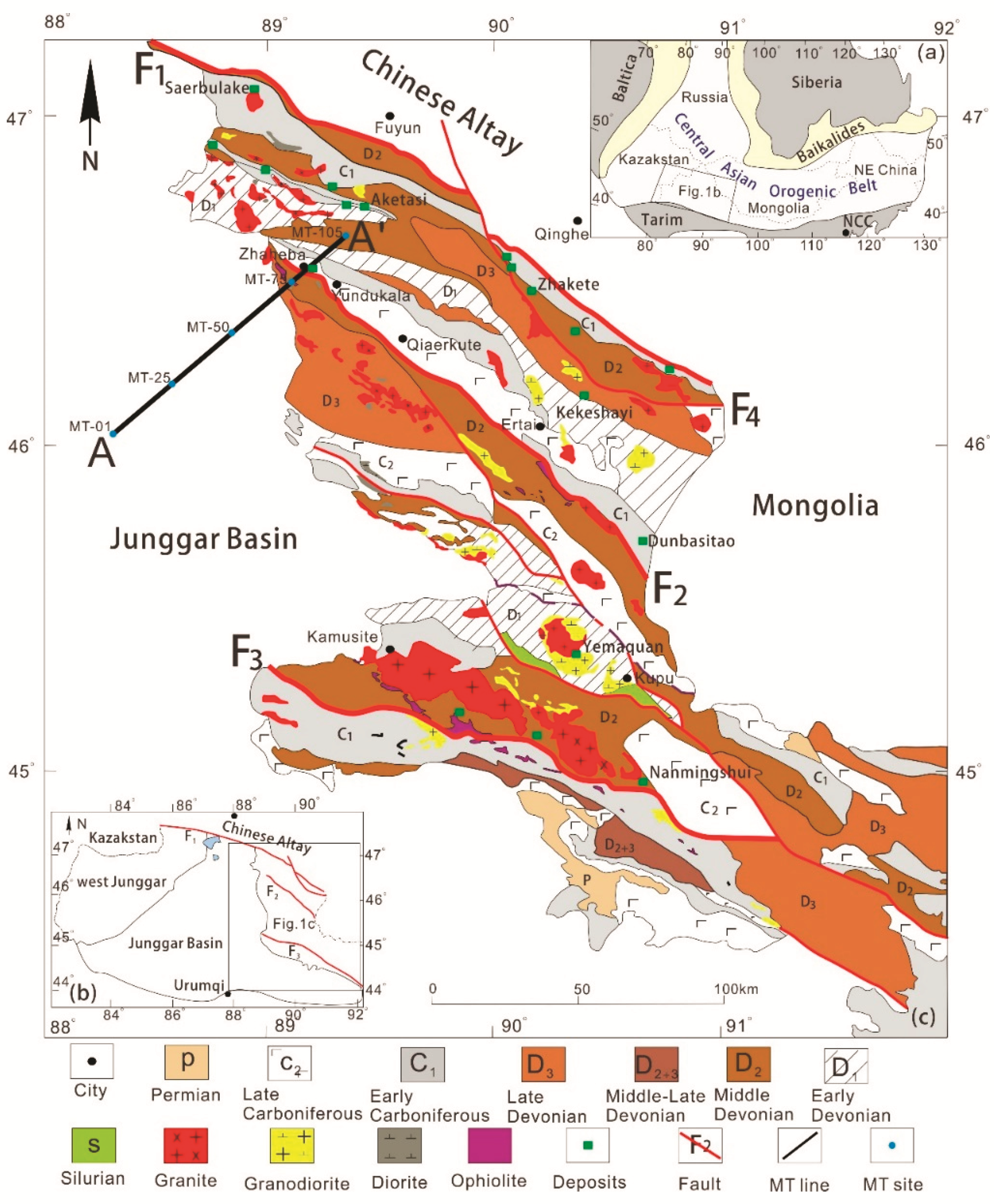
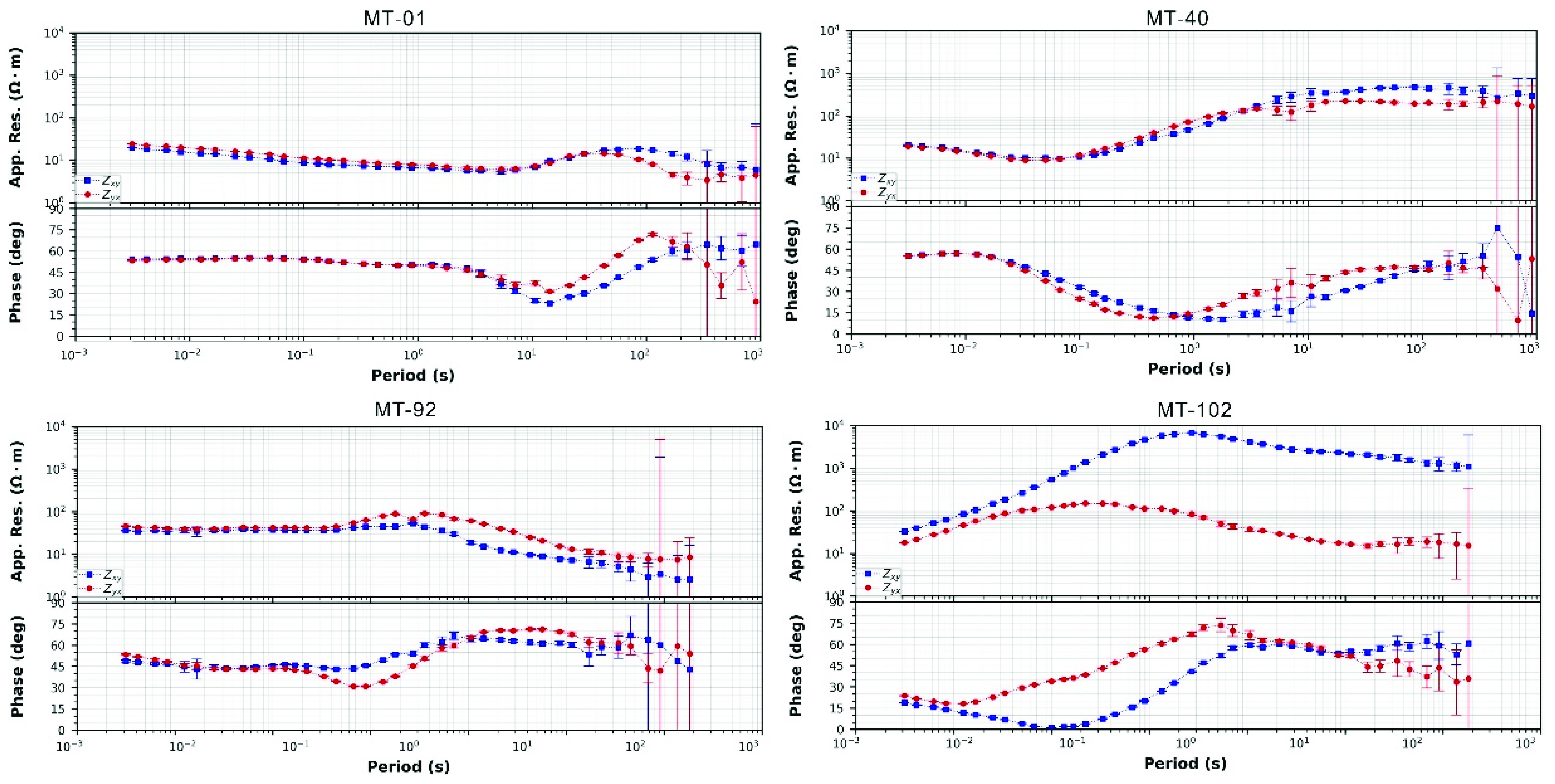

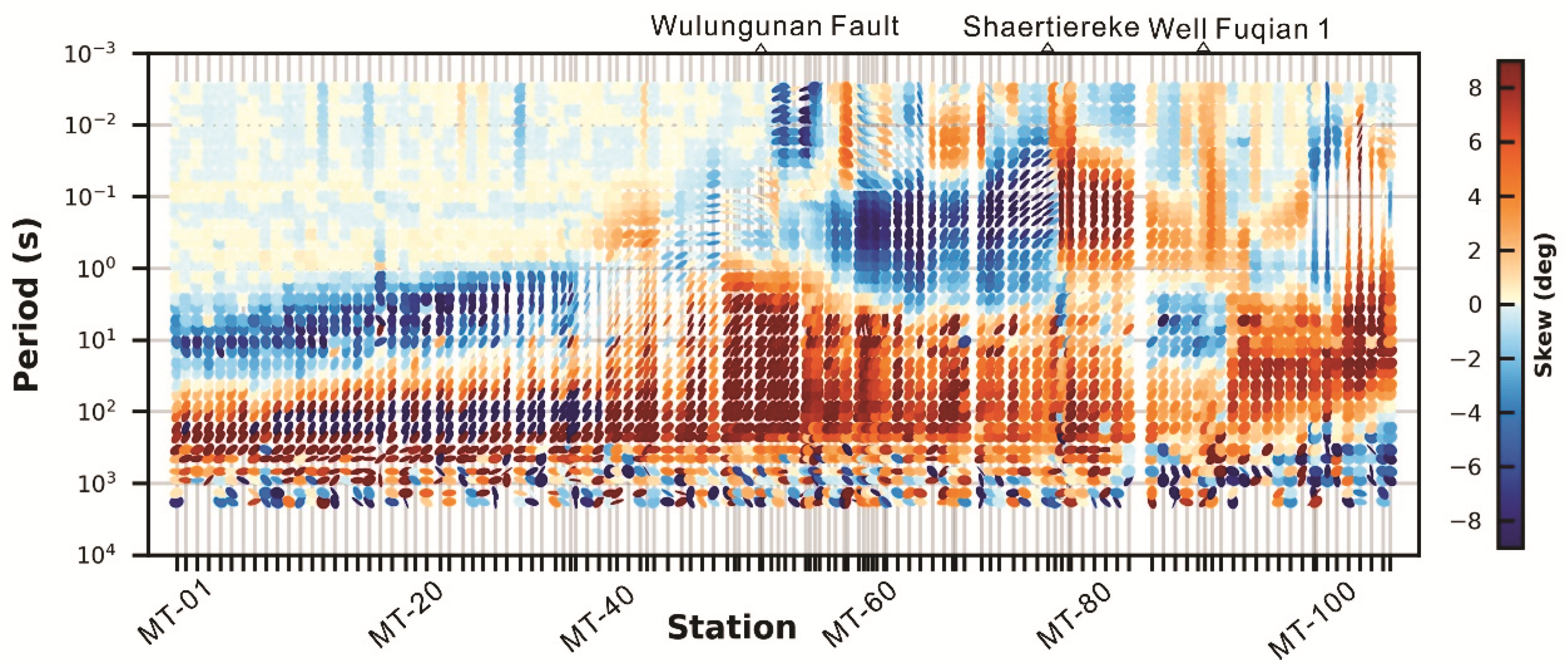
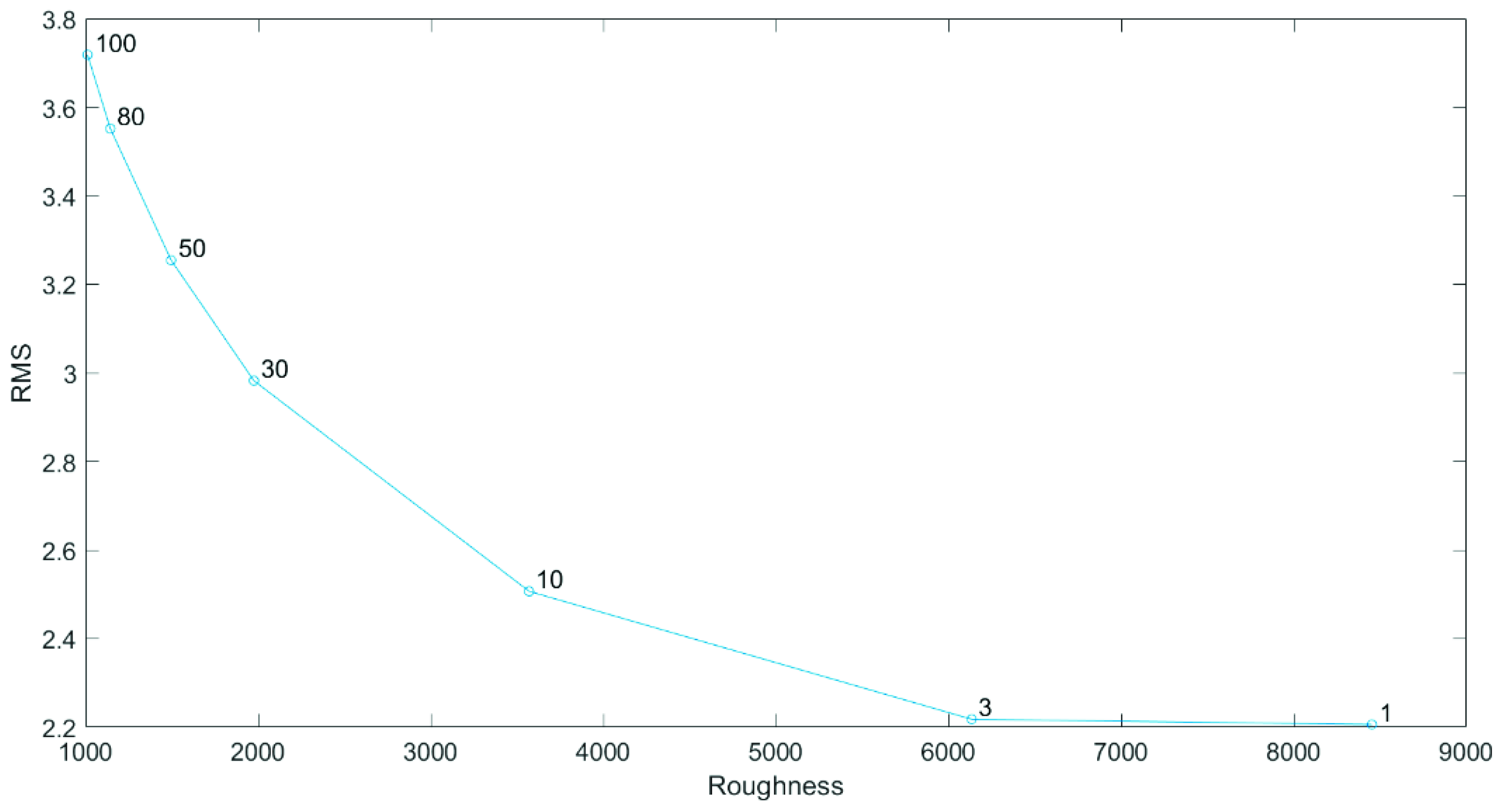
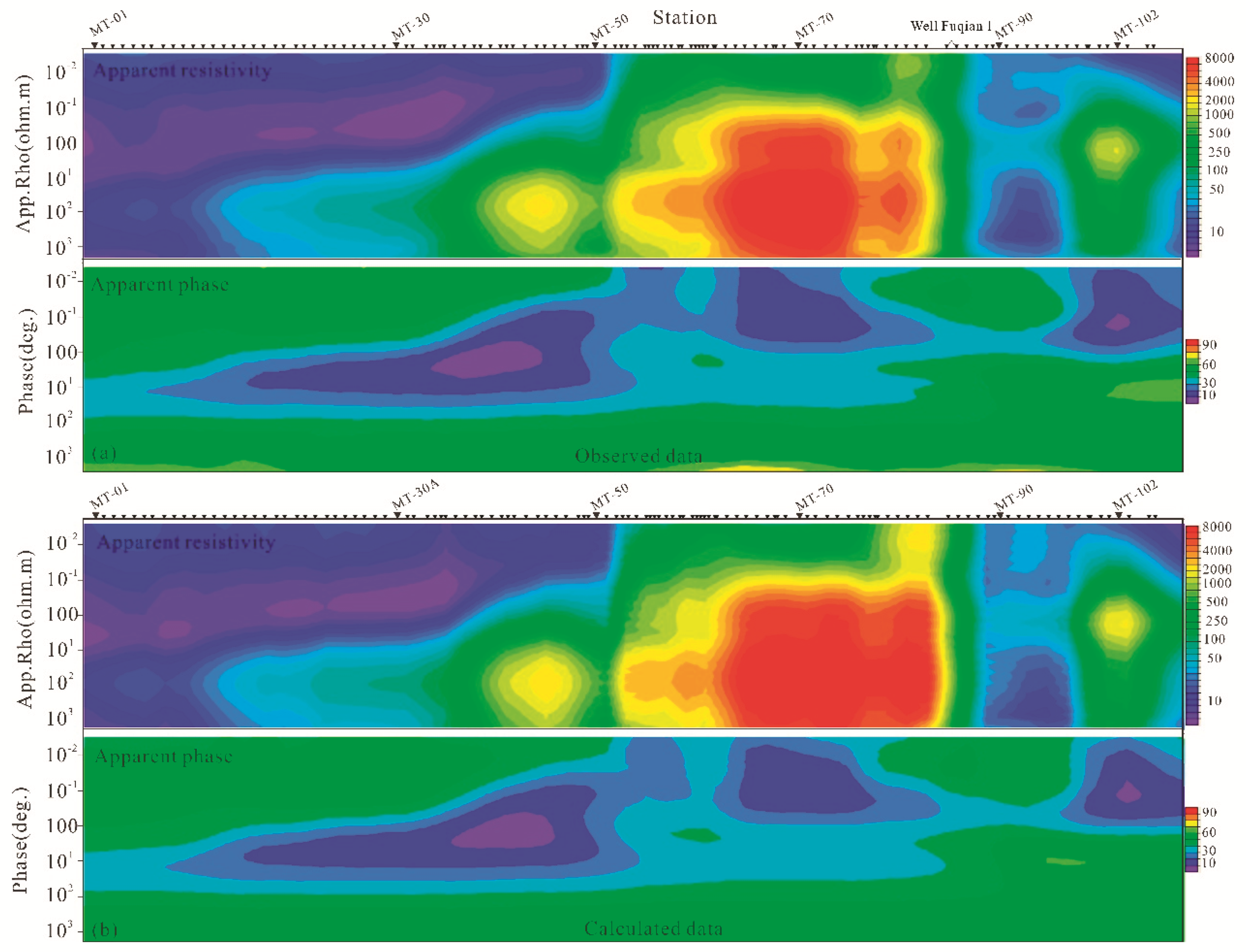
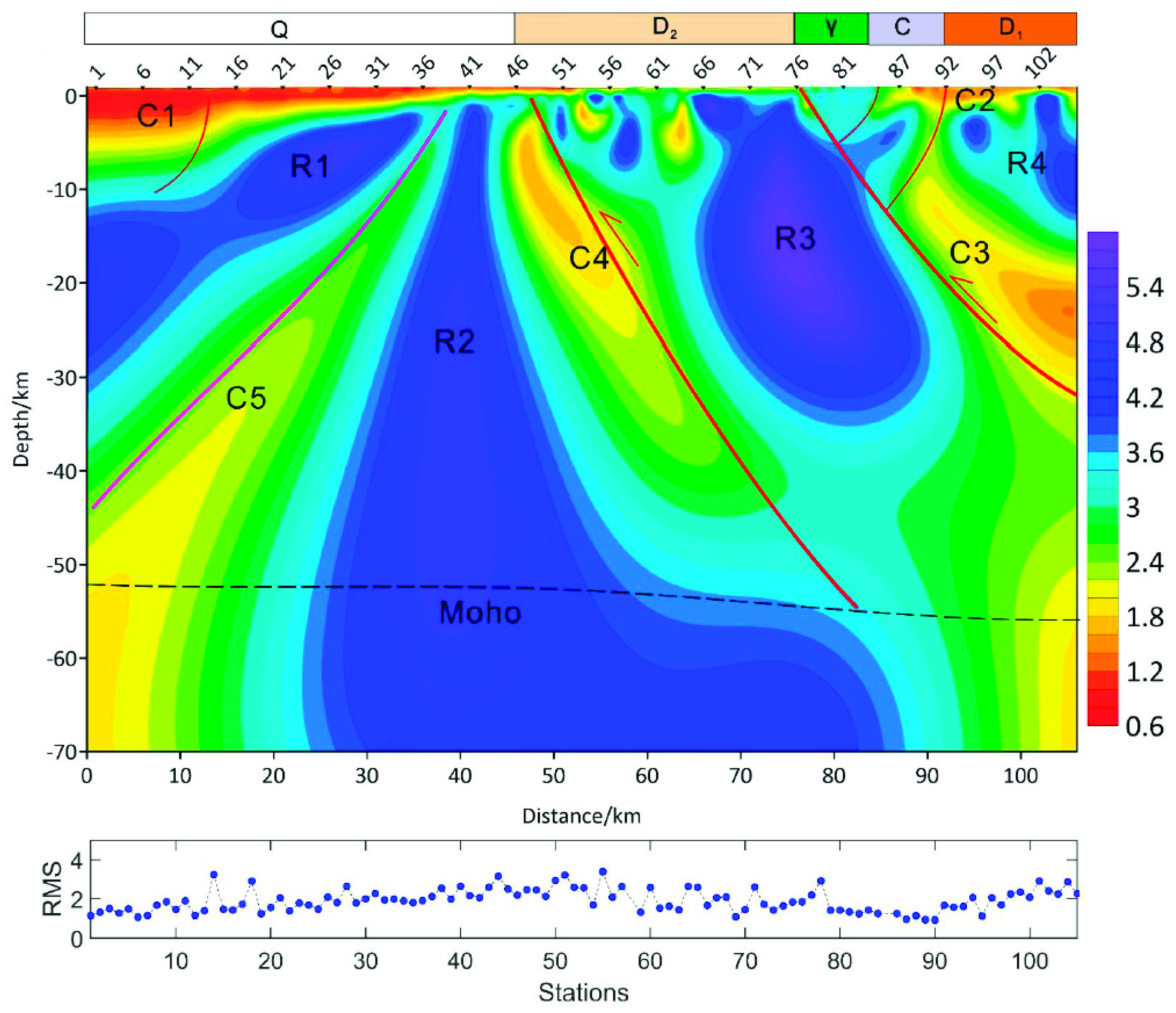
| Strata | Rock Types | Resistivity (Ω·m) |
|---|---|---|
| Quaternary-Permian | Mudstone | 560 |
| Sandstone | 580 | |
| Carboniferous | Mudstone | 840 |
| Sandstone | 690 | |
| Tuff | 1540 | |
| Pyroclastic rock | 1985 | |
| Devonian to Ordovician | Schist | 3040 |
| Gneiss | 3300 | |
| Magmatic rock | Diabase | 3200 |
| Basalt | 3350 | |
| Granite | 3500 |
Publisher’s Note: MDPI stays neutral with regard to jurisdictional claims in published maps and institutional affiliations. |
© 2021 by the authors. Licensee MDPI, Basel, Switzerland. This article is an open access article distributed under the terms and conditions of the Creative Commons Attribution (CC BY) license (https://creativecommons.org/licenses/by/4.0/).
Share and Cite
Zhang, P.; Yu, C.; Zeng, X. Crustal Electrical Structure of the Zhaheba Complex Imaged by Magnetotelluric Data and Its Tectonic Implications. Appl. Sci. 2021, 11, 10013. https://doi.org/10.3390/app112110013
Zhang P, Yu C, Zeng X. Crustal Electrical Structure of the Zhaheba Complex Imaged by Magnetotelluric Data and Its Tectonic Implications. Applied Sciences. 2021; 11(21):10013. https://doi.org/10.3390/app112110013
Chicago/Turabian StyleZhang, Pingchuan, Changqing Yu, and Xiangzhi Zeng. 2021. "Crustal Electrical Structure of the Zhaheba Complex Imaged by Magnetotelluric Data and Its Tectonic Implications" Applied Sciences 11, no. 21: 10013. https://doi.org/10.3390/app112110013
APA StyleZhang, P., Yu, C., & Zeng, X. (2021). Crustal Electrical Structure of the Zhaheba Complex Imaged by Magnetotelluric Data and Its Tectonic Implications. Applied Sciences, 11(21), 10013. https://doi.org/10.3390/app112110013






